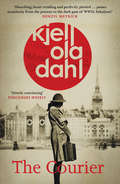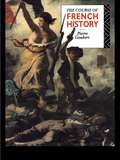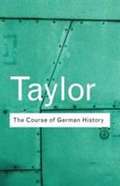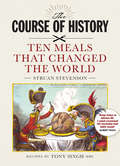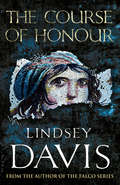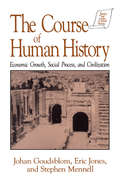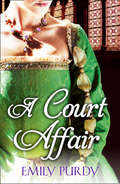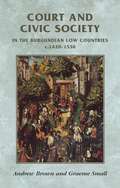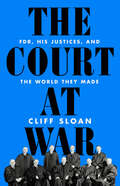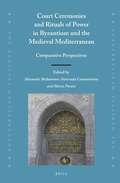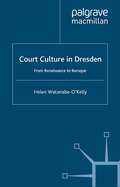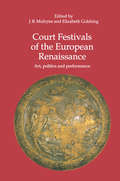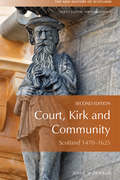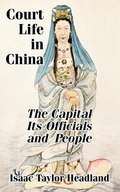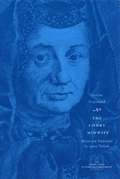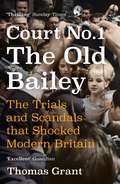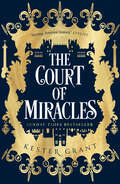- Table View
- List View
The Courier
by Kjell Ola DahlThe international bestselling godfather of Nordic Noir takes on one of the most horrific periods of modern history, in a stunning standalone thriller … NUMBER ONE BESTSELLER‘The Courier is a stylish stand-alone thriller from the godfather of Scandi noir … Ola Dahl ratchets up the tension from the first pages and never lets go’ The Times‘Cleverly braiding together past and present, the who and why of murder and betrayal are unpicked. The detail is impressive’ Daily MailIn 1942, Jewish courier Ester is betrayed, narrowly avoiding arrest by the Gestapo. In a great haste, she escapes to Sweden, saving herself. Her family in Oslo, however, is deported to Auschwitz. In Stockholm, Ester meets the resistance hero, Gerhard Falkum, who has left his little daughter and fled both the Germans and allegations that he murdered his wife, Åse, who helped Ester get to Sweden. Their burgeoning relationship ends abruptly when Falkum dies in a fire.And yet, twenty-five years later, Falkum shows up in Oslo. He wants to reconnect with his daughter. But where has he been, and what is the real reason for his return? Ester stumbles across information that forces her to look closely at her past, and to revisit her war-time training to stay alive…Written with Dahl's trademark characterization and elegant plotting, The Courier sees the hugely respected godfather of Nordic Noir at his best, as he takes on one of the most horrific periods of modern history, in an exceptional, shocking thriller.‘Absorbing, heart-rending and perfectly plotted. Kjell Ola Dahl’s The Courier passes seamlessly from the present to the dark past of WWII. Fabulous!’ Denzil Meyrick‘Skilfully juggling three Oslo timelines — in 1942, 1967 and 2015 — Dahl starts his story with Germany’s occupation of Norway and the work of those who tried to resist, then brings his characters forward to a post-war unravelling of what really happened in those dangerous days — and the traumatic rewriting of personal stories’ The Times Crime Club‘The Courier is very good on the socio-political situation of the time, the relationship between Norway and neutral neighbour Sweden. This is a gritty but ultimately uplifting story. Superbly translated by Don Bartlett’ NB Magazine‘A fascinating, intricate, provocative read, set in motion by events in 1942, and brilliantly highlighting human need and emotions … ‘The Courier’ sent a shiver coursing through me, it is a truly eloquent and rewarding tale, and oh that ending!’ LoveReading‘Written with Dahl’s trademark characterisation and clever plotting, The Courier sees one of Norway’s most critically acclaimed authors at his best … This stunning and compelling wartime thriller is reminiscent of the writing of John Le Carré and William Boyd’ New Books Magazine‘Utterly convincing’ Publishers Weekly‘Kjell Ola Dahl’s novels are superb. If you haven’t read one, you need to – right now’ William Ryan‘More than gripping’ European Literature Network‘The perfect example of why Nordic Noir has become such a popular genre’ Reader’s Digest‘It all comes together, of course, in the kind of masterful, detailed plotting that Dahl is known for … the power of The Courier is how Dahl has given a complex, human face to such an inhuman tragedy’ Crime Fiction Lover‘Atmospheric thriller with lots of great twists and loved the scandi wartime story in particular. Gripping will be recommending to readers’ Edgy Books
The Course of French History
by Pierre GoubertThis stimulating one-volume history traces the social and economic evolution of France as a nation from the founding of the monarchy in 987, to the present day.Against a background of structural change, Goubert etches a vivid account of key events and personalities. His perspective is a popular one, and his main interest is in how political events and famous people affect the nation as a whole. The book incorporates the findings and perspectives of recent monographic studies with clarity and precision, but it is Goubert's own judgements, direct, forceful and iconoclastic, which make this an invaluable text.
The Course of French History
by Pierre GoubertThis stimulating one-volume history traces the social and economic evolution of France as a nation from the founding of the monarchy in 987, to the present day.Against a background of structural change, Goubert etches a vivid account of key events and personalities. His perspective is a popular one, and his main interest is in how political events and famous people affect the nation as a whole. The book incorporates the findings and perspectives of recent monographic studies with clarity and precision, but it is Goubert's own judgements, direct, forceful and iconoclastic, which make this an invaluable text.
The Course Of German History: A Survey Of The Development Of German History Since 1815 (Routledge Classics Ser. (PDF))
by A. TaylorOne of A.J.P. Taylor's best-known books, The Course of German History is a notoriously idiosyncratic work. Composed in his famously witty style, yet succinct to the point of sharpness, this is one of the great historian's finest, if more controversial, accomplishments. As Taylor himself noted, 'the history of the Germans is a history of extremes. It contains everything except moderation.' He could, of course, simply be referring to his own book.
The Course of History: Ten Meals that Changed the World
by Struan StevensonMany decisions which have had enormous historical consequences have been made over the dinner table, and have been accompanied (and perhaps influenced) by copious amounts of food and wine. In The Course of History Struan Stevenson brings to life ten such moments, exploring the personalities, the issues and of course the food which helped shape the course of history.From the claret consumed on the eve of the Battle of Culloden, through the dinners which decided the fates of George Washington, Archduke Ferdinand and Adolf Hitler, to the diplomatic feasts that decided future relations with Russia, China and the Middle East, each chapter covers every detail, character, decision and morsel which decided the course of history.
The Course Of Honour
by Lindsey DavisA true, historical love story from the bestselling author of the Falco novels.‘He has no money, no reputation and no famous ancestors.’The love story of the Emperor Vespasian, who brought peace to Rome after years of strife, and his mistress, the freed slave woman Caenis, this book recreates Ancient Rome’s most turbulent period – the reigns of Tiberius, Caligula, Claudius and Nero and Vespasian’s rise to power. As their forbidden romance blossoms, Caenis is embroiled in political intrigue, while Vespasian embarks on a glorious career. Years pass, then Vespasian risks all in the climactic struggle for power – bringing hope for Rome, but a threat to the relationship that has endured for so long.
The Course of Human History: Civilization and Social Process
by Stephen Mennell David M Jones Johan GoudsblomThis text explores four major features of human society in their ecological and historical context: the origins of priests and organised religion; the rise of military men in an agrarian society; economic expansion and growth; and civilising and decivilising trends over time.
The Course of Human History: Civilization and Social Process (Sources And Studies In World History Ser.)
by Stephen Mennell David M Jones Johan GoudsblomThis text explores four major features of human society in their ecological and historical context: the origins of priests and organised religion; the rise of military men in an agrarian society; economic expansion and growth; and civilising and decivilising trends over time.
A Court Affair
by Emily PurdyPassion, Treachery, Betrayal. The virgin queen has arrived… Uncovering the love triangle between Queen Elizabeth I, Robert Dudley, and his wife Amy, and her mysterious death,A Court Affair is an unforgettable story of ambition, lust and jealousy.
Court and civic society in the Burgundian Low Countries c.1420–1530 (Manchester Medieval Sources)
by Andrew Brown Graeme SmallThis volume is the first ever attempt to unite and translate some of the key texts which informed Johan Huizinga’s famous study of the Burgundian court, The Waning of the Middle Ages, a work which has never gone out of print. It combines these texts with sources that Huizinga did not consider, those that illuminate the wider civic world that the Burgundian court inhabited and the dynamic interaction between court and city. Through these sources, and an introduction offering new perspectives on recent historiography, the book tests whether Huizinga’s controversial vision of the period still stands. Covering subjects including ceremonial events, such as the spectacles and gargantuan banquets that made the Burgundian dukes the talk of Europe, the workings of the court, and jousting, archery and rhetoric competitions, the book will appeal to students of late medieval and early modern Europe and to those with wider interests in court culture, ritual and ceremony.
The Court at War: FDR, His Justices, and the World They Made
by Cliff SloanThe inside story of how one president forever altered the most powerful legal institution in the country—with consequences that endure today By the summer of 1941, in the ninth year of his presidency, Franklin Roosevelt had molded his Court. He had appointed seven of the nine justices—the most by any president except George Washington—and handpicked the chief justice. But the wartime Roosevelt Court had two faces. One was bold and progressive, the other supine and abject, cowed by the charisma of the revered president. The Court at War explores this pivotal period. It provides a cast of unforgettable characters in the justices—from the mercurial, Vienna-born intellectual Felix Frankfurter to the Alabama populist Hugo Black; from the western prodigy William O. Douglas, FDR&’s initial pick to be his running mate in 1944, to Roosevelt&’s former attorney general and Nuremberg prosecutor Robert Jackson. The justices&’ shameless capitulation and unwillingness to cross their beloved president highlight the dangers of an unseemly closeness between Supreme Court justices and their political patrons. But the FDR Court&’s finest moments also provided a robust defense of individual rights, rights the current Court has put in jeopardy. Sloan&’s intimate portrait is a vivid, instructive tale for modern times.
Court Ceremonies And Rituals Of Power In Byzantium And The Medieval Mediterranean: Comparative Perspectives (The\medieval Mediterranean Ser. #98)
by Alexander Beihammer Stavroula Constantinou Maria G. ParaniPublicly performed rituals and ceremonies form an essential part of medieval political practice and court culture. This applies not only to western feudal societies, but also to the linguistically and culturally highly diversified environment of Byzantium and the Mediterranean basin. The continuity of Roman traditions and cross-fertilization between various influences originating from Constantinople, Armenia, the Arab-Muslim World, and western kingdoms and naval powers provide the framework for a distinct sphere of ritual expression and ceremonial performance. This collective volume, placing Byzantium into a comparative perspective between East and West, examines transformative processes from Late Antiquity to the Middle Ages, succession procedures in different political contexts, phenomena of cross-cultural appropriation and exchange, and the representation of rituals in art and literature. Contributors are Maria Kantirea, Martin Hinterberger, Walter Pohl, Andrew Marsham, Björn Weiler, Eric J. Hanne, Antonia Giannouli, Jo Van Steenbergen, Stefan Burkhardt, Ioanna Rapti, Jonathan Shepard, Panagiotis Agapitos, Henry Maguire, Christine Angelidi and Margaret Mullett.
Court Culture in Dresden
by H. Watanabe-O'KellyThis is the first cultural history of Baroque Dresden, the capital of Saxony and the most important Protestant territory in the Empire from the mid-sixteenth to the early eighteenth century. Helen Watanabe-O'Kelly shows how the art patronage of the Electors fits into the intellectual climate of the age and investigates its political and religious context. Lutheran church music and architecture, the influence of Italy, the cabinet of curiosities and the culture of collecting, alchemy, mining and early technology, official image-making and court theatre are some of the wealth of colourful subjects dealt with during the period 1553 to 1733.
Court Festivals of the European Renaissance: Art, Politics and Performance
by J. R. Mulryne Elizabeth GoldringFestival culture is an area which has attracted increasing interest in the field of Renaissance studies in recent years. In part the outcome of scholars' focus on the place of the city in the establishment and dissemination of common culture, the attention paid to festivals also arises from the interdisciplinary nature of the topic, which reaches across the usual demarcation lines between disciplines such as cultural, political and economic history, literature, and the visual and performing arts. The scholars contributing to this volume include representatives from all these disciplines. Their essays explore common themes in festival culture across Renaissance Europe, including the use of festival in political self-fashioning and the construction of a national self-image. Moreover, in their detailed examination of particular types of festival, they challenge generalizations and demonstrate the degree to which these events were influenced the personality of the prince, the sources of funding for the ceremony, and the role of festival managers. Usually perceived as binding forces promoting social cohesion, festivals held the potential for discord, as some of the essays here reveal. Examining a wide range of festivals including coronations, triumphal entries, funerals and courtly spectacles, this volume provides a more inclusive understanding than hitherto of festivals and their role in European Renaissance culture.
Court Festivals of the European Renaissance: Art, Politics and Performance
by J. R. Mulryne Elizabeth GoldringFestival culture is an area which has attracted increasing interest in the field of Renaissance studies in recent years. In part the outcome of scholars' focus on the place of the city in the establishment and dissemination of common culture, the attention paid to festivals also arises from the interdisciplinary nature of the topic, which reaches across the usual demarcation lines between disciplines such as cultural, political and economic history, literature, and the visual and performing arts. The scholars contributing to this volume include representatives from all these disciplines. Their essays explore common themes in festival culture across Renaissance Europe, including the use of festival in political self-fashioning and the construction of a national self-image. Moreover, in their detailed examination of particular types of festival, they challenge generalizations and demonstrate the degree to which these events were influenced the personality of the prince, the sources of funding for the ceremony, and the role of festival managers. Usually perceived as binding forces promoting social cohesion, festivals held the potential for discord, as some of the essays here reveal. Examining a wide range of festivals including coronations, triumphal entries, funerals and courtly spectacles, this volume provides a more inclusive understanding than hitherto of festivals and their role in European Renaissance culture.
Court, Kirk, and Community: Scotland 1470-1625
by Jenny WormaldIntervenes in contemporary debates about the relationship between literature and field recording
Court, Kirk, and Community: Scotland 1470-1625 (Edinburgh University Press)
by Jenny WormaldContextualizes the refugee crisis through a historical study of Muslim mobility and violence
Court Life in China: The Capital, Its Officials and People
by Isaac Taylor HeadlandOriginally published in 1909, when in the Preface it was said: "Until the past ten years a study of Chinese court life would have been an impossibility. The Emperor, the Empress Dowager, and the court ladies were shut up within the Forbidden City, away from a world they were anxious to see, and which was equally anxious to see them. Then the Emperor instituted reform, the Empress Dowager came out from behind the screen, and the court entered into social relations with Europeans. ""For twenty years and more Mrs. Headland has been physician to the family of the Empress Dowager's mother, the Empress' sister, and many of the princesses and high official ladies in Peking. She has visited them in a social as well as professional way, has taken her friends, to whom the princesses have shown many favours, and they have themselves been constant callers at our home. It is to my wife, therefore, that I am indebted for much of the information contained in this book. "Isaac Taylor Headland was a Professor inthe Peking University.
The Court Midwife (The Other Voice in Early Modern Europe)
by Justine SiegemundFirst published in 1690, The Court Midwife made Justine Siegemund (1636-1705) the spokesperson for the art of midwifery at a time when most obstetrical texts were written by men. More than a technical manual, The Court Midwife contains descriptions of obstetric techniques of midwifery and its attendant social pressures. Siegemund's visibility as a writer, midwife, and proponent of an incipient professionalism accorded her a status virtually unknown to German women in the seventeenth century. Translated here into English for the first time, The Court Midwife contains riveting birthing scenes, sworn testimonials by former patients, and a brief autobiography.
The Court Midwife (The Other Voice in Early Modern Europe)
by Justine SiegemundFirst published in 1690, The Court Midwife made Justine Siegemund (1636-1705) the spokesperson for the art of midwifery at a time when most obstetrical texts were written by men. More than a technical manual, The Court Midwife contains descriptions of obstetric techniques of midwifery and its attendant social pressures. Siegemund's visibility as a writer, midwife, and proponent of an incipient professionalism accorded her a status virtually unknown to German women in the seventeenth century. Translated here into English for the first time, The Court Midwife contains riveting birthing scenes, sworn testimonials by former patients, and a brief autobiography.
The Court Midwife (The Other Voice in Early Modern Europe)
by Justine SiegemundFirst published in 1690, The Court Midwife made Justine Siegemund (1636-1705) the spokesperson for the art of midwifery at a time when most obstetrical texts were written by men. More than a technical manual, The Court Midwife contains descriptions of obstetric techniques of midwifery and its attendant social pressures. Siegemund's visibility as a writer, midwife, and proponent of an incipient professionalism accorded her a status virtually unknown to German women in the seventeenth century. Translated here into English for the first time, The Court Midwife contains riveting birthing scenes, sworn testimonials by former patients, and a brief autobiography.
Court Number One: The Old Bailey Trials that Defined Modern Britain
by Thomas Grant'These tales of eleven trials are shocking, squalid, titillating and illuminating: each of them says something fascinating about how our society once was' The Times'A hamper of treats ... Grant is a master at conveying the cut-and-thrust of cross-examination' Sunday Telegraph'Deceptively thrilling' Sunday Times'Excellent . . . Thomas Grant offers detailed accounts of 11 cases at the Old Bailey's Court Number One, with protagonists ranging from the diabolical to the pathetic. There is humour . . . but this is ultimately an affecting study of how the law gets it right - and wrong' GuardianCourt Number One of the Old Bailey is the most famous court room in the world, and the venue of some of the most sensational human dramas ever to be played out in a criminal trial.The principal criminal court of England, historically reserved for the more serious and high-profile trials, Court Number One opened its doors in 1907 after the building of the 'new' Old Bailey. In the decades that followed it witnessed the trials of the most famous and infamous defendants of the twentieth century. It was here that the likes of Madame Fahmy, Lord Haw Haw, John Christie, Ruth Ellis, George Blake (and his unlikely jailbreakers, Michael Randle and Pat Pottle), Jeremy Thorpe and Ian Huntley were defined in history, alongside a wide assortment of other traitors, lovers, politicians, psychopaths, spies, con men and - of course - the innocent. Not only notorious for its murder trials, Court Number One recorded the changing face of modern British society, bearing witness to alternate attitudes to homosexuality, the death penalty, freedom of expression, insanity and the psychology of violence. Telling the stories of twelve of the most scandalous and celebrated cases across a radically shifting century, this book traces the evolving attitudes of Britain, the decline of a society built on deference and discretion, the tensions brought by a more permissive society and the rise of trial by mass media.From the Sunday Times bestselling author of Jeremy Hutchinson's Case Histories, Court Number One is a mesmerising window onto the thrills, fears and foibles of the modern age.
A Court of Betrayal: The gripping new historical novel from the Sunday Times bestselling author!
by Anne O'Brien'A fantastically gripping story of love and betrayal, told with the masterful skill of a passionate storyteller. It kept me riveted until the last page!' BARBARA ERSKINE'Anne O'Brien crosses swathes of time seamlessly. A gorgeous bouquet of a novel. Stunning' CAROL McGRATHALL'S FAIR IN LOVE AND WAR...The Welsh Marches, 1301Strong-willed heiress Johane de Geneville is married to Roger Mortimer, Earl of March, at just fifteen years old.Soon Johane finds herself swept up in a world of treacherous court politics and dangerous secrets as her husband deposes Edward II and rules England alongside Queen Isabella. Yet when Roger is accused of treason, she is robbed of her freedom and must survive catastrophic events in her fight for justice - with her life, and her children's, hanging in the balance...Will she pay for her husband's mistakes, or will she manage to escape from a terrible fate?Readers love Anne O'Brien:'I was spellbound throughout!' ⭐⭐⭐⭐⭐'Vividly real and unforgettable' ⭐⭐⭐⭐⭐'Truly captivating' ⭐⭐⭐⭐⭐ 'If you love historical heroines and women battling to survive against all the odds, this is for you!' ⭐⭐⭐⭐⭐'Superbly written, a jolly good read!' ⭐⭐⭐⭐⭐
Court of Lions
by Jane JohnsonKate Fordham fled to Spain to start a new life. Amid the sunlit streets of Granada and the earthly paradise of the Alhambra's gardens, towers and courtyards, she's left her past far behind. But fate is about to bring her face-to-face with her greatest fear. Five centuries ago, a message was hidden in the Alhambra's walls. There it has lain, undisturbed by the tides of history – the fall of Granada, the expulsion of its last Sultan – until Kate discovers it. Born of love in a time of desperation and danger, Kate's discovery will be the catalyst that changes her life.
The Court of Miracles (The Court of Miracles Trilogy #1)
by Kester GrantLes Misérables meets Six of Crows in this page-turning adventure as a young thief finds herself going head to head with leaders of Paris's criminal underground in the wake of a failed French Revolution.
